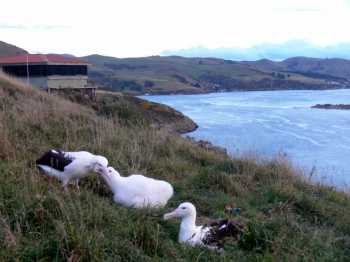Yvan Richard (Dragonfly Science, Wellington, New Zealand) and colleagues have produced a report on aspects of the demography of the growing population of Northern Royal Albatrosses Diomedea sanfordi that breed on the mainland of South Island, New Zealand at Taiaroa Head. Their research was funded by the Conservation Services Programme of New Zealand’s Department of Conservation.
The report’s Executive Summary follows:
“In a recent risk assessment, northern royal albatross was identified as one the seabird species most at risk from incidental captures in commercial fisheries in New Zealand. The uncertainty of the estimated risk was large, owing to its sensitivity to the uncertainty surrounding existing estimates of the annual survival rate. This highlights the need for accurate demographic measures of this species. Demographic rates, such as the annual survival rate, are generally difficult to estimate for long-lived seabirds such as northern royal albatross, because of the length of the study required and the remoteness of colonies. Data from a small population of northern royal albatross (Diomedea sanfordi) that self-established on the mainland of New Zealand at Taiaroa Head, provided a unique data set for the estimation of demographic rates. Banding as well as monitoring of individuals has been carried out at the Taiaroa Head colony since 1938. Data on the presence/absence of birds, as well as on breeding outcomes, were available for the period between 1989–90 and 2011–12, and included 2128 annual resightings of 355 banded individuals of known-age. The main goal of the present study was to estimate the annual survival rate of juveniles, pre-breeders, and adults at Taiaroa Head. These rates were estimated simultaneously in a single Bayesian multi-state capture-recapture model. Several models were fitted to the data, with different levels of complexity. From the most parsimonious model, the overall annual adult survival rate was estimated as 0.95 (95% c.i.: 0.941–0.959). In this model, adult survival declined with age, from 0.976 (95% c.i.: 0.963–0.988) at 6 years, the minimum age at first breeding, to 0.915 (95% c.i.: 0.879–0.946) at 40 years. Mean annual survival of pre-breeders was 0.966 (95% c.i.: 0.95–0.98), and 0.933 (95% c.i.: 0.908–0.966) for juveniles. There was no discernible difference in survival between males and females, and there was no apparent trend in survival over time. Estimates of other demographic rates were also obtained during the estimation process. The mean age at first return of juveniles to the colony was estimated as 4.81 years (95% c.i.: 4.63–5.06), and the mean age at first breeding as 8.85 years (95% c.i.: 8.53–9.29). The number of northern royal albatross present annually at the Taiaroa Head colony has doubled since 1989–90, and the current total population size was estimated to be over 200 individuals. The ratio of the total population size to the number of annual breeding pairs varied between 5 and 12 among years, with an overall mean of 7.65 (95% c.i.: 7.56–7.78). While long-term data allowed estimates of demographic rates of northern royal albatross at Taiaroa Head, the location of the colony and the ongoing management by staff mean that the population dynamics may differ from those of the main population on the Chatham Islands.”

A family of Northern Royal Albatrosses at Taiaroa Head
Photograph by Junichi Sugushita
Reference:
Y. Richard, L. Perriman, C. Lalas & E.R. Abraham 2013. Demographic Rates of Northern Royal Albatross at Taiaroa Head, New Zealand. Wellington: Dragonfly Science. 24 pp.
John Cooper, ACAP Information Officer, 20 August 2013

 English
English  Français
Français  Español
Español